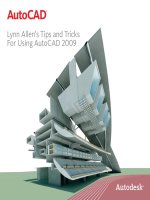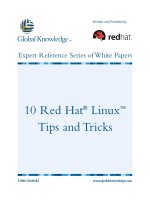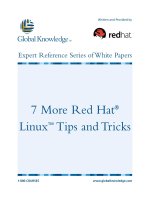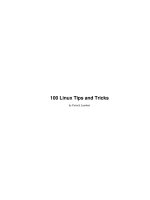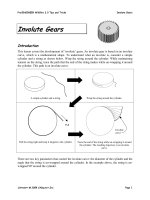direct3d shaderx - vertex and pixel shader tips and tricks
Bạn đang xem bản rút gọn của tài liệu. Xem và tải ngay bản đầy đủ của tài liệu tại đây (10.27 MB, 524 trang )
Direct3D ShaderX
Vertex and Pixel Shader
Tips and Tricks
Edited by Wolfgang F. EngelEdited by Wolfgang F. Engel
Wordware Publishing, Inc.Wordware Publishing, Inc.
Team LRN
Library of Congress Cataloging-in-Publication Data
Direct3d ShaderX : vertex and pixel shader tips and tricks / edited by
Wolfgang F. Engel.
p. cm.
Includes bibliographical references and index.
ISBN 1-55622-041-3
1. Computer games Programming. 2. Three-dimensional display systems.
3. Direct3D. I. Engel, Wolfgang F.
QA76.76.C672 D57 2002
794.8'15265 dc21
2002006571
© 2002, Wordware Publishing, Inc.
All Rights Reserved
2320 Los Rios Boulevard
Plano, Texas 75074
No part of this book may be reproduced in any form or by any means
without permission in writing from Wordware Publishing, Inc.
Printed in the United States of America
ISBN 1-55622-041-3
10987654321
0502
RenderMan is a registered trademark of Pixar Animation Studios.
krass engine is a trademark of Massive Development.
3D Studio Max is a registered trademark of Autodesk/Discreet in the USA and/or other countries.
GeForce is a trademark of NVIDIA Corporation in the United States and/or other countries.
Some figures in this book are copyright ATI Technologies, Inc., and are used with permission.
Other product names mentioned are used for identification purposes only and may be trademarks of their respective companies.
All inquiries for volume purchases of this book should be addressed to Wordware Publishing, Inc., at the above
address. Telephone inquiries may be made by calling:
(972) 423-0090
Team LRN
Contents
Foreword xvi
Acknowledgments xvii
Part 1: Introduction to Shader Programming
Fundamentals of Vertex Shaders 4
Wolfgang F. Engel
What You Need to Know/Equipment 5
Vertex Shaders in the Pipeline 5
Why Use Vertex Shaders? 7
Vertex Shader Tools 8
NVIDIA Effects Browser 2/3 8
NVIDIA Shader Debugger 9
Shader City 10
Vertex Shader Assembler 10
NVIDIA NVASM — Vertex and Pixel Shader Macro Assembler 10
Microsoft Vertex Shader Assembler 11
Shader Studio 11
NVLink 2.x 12
NVIDIA Photoshop Plug-ins 13
Diffusion Cubemap Tool 14
DLL Detective with Direct3D Plug-in 15
3D Studio Max 4.x/gmax 1.1 16
Vertex Shader Architecture 16
High-Level View of Vertex Shader Programming 18
Check for Vertex Shader Support 19
Vertex Shader Declaration 19
Set the Vertex Shader Constant Registers 22
Write and Compile a Vertex Shader 22
Application Hints 26
Complex Instructions in the Vertex Shader 27
Putting It All Together 27
Swizzling and Masking 31
Guidelines for Writing Vertex Shaders 32
Compiling a Vertex Shader 33
Create a Vertex Shader 34
Set a Vertex Shader 34
Free Vertex Shader Resources 35
Summary 35
What Happens Next? 35
iii
Team LRN
Programming Vertex Shaders 38
Wolfgang F. Engel
RacorX 38
The Common Files Framework 40
Check for Vertex Shader Support 42
Vertex Shader Declaration 42
Set the Vertex Shader Constant Registers 43
The Vertex Shader 43
Compile a Vertex Shader 45
Create a Vertex Shader 46
Set a Vertex Shader 47
Free Vertex Shader Resources 47
Non-Shader Specific Code 47
Summary 49
RacorX2 49
Create a Vertex Shader 51
Summary 53
RacorX3 53
Vertex Shader Declaration 54
Set the Vertex Shader Constant Registers 54
The Vertex Shader 55
Directional Light 57
Diffuse Reflection 57
Summary 59
RacorX4 59
Vertex Shader Declaration 59
Set the Vertex Shader Constants 60
The Vertex Shader 61
Specular Reflection 62
Non-Shader Specific Code 65
Summary 66
RacorX5 66
Point Light Source 66
Light Attenuation for Point Lights 66
Set the Vertex Shader Constants 67
The Vertex Shader 68
Summary 70
What Happens Next? 70
Fundamentals of Pixel Shaders 72
Wolfgang F. Engel
Why Use Pixel Shaders? 72
Pixel Shaders in the Pipeline 74
Pixel Shader Tools 79
Microsoft Pixel Shader Assembler 79
MFC Pixel Shader 80
iv Contents
Team LRN
ATI ShadeLab 80
Pixel Shader Architecture 81
Constant Registers (c0-c7) 82
Output and Temporary Registers (ps.1.1-ps.1.3: r0+r1; ps.1.4: r0-r5) 82
Texture Registers (ps.1.1-ps.1.3: t0-t3; ps.1.4: t0-t5) 82
Color Registers (ps.1.1-ps.1.4: v0+v1) 83
Range 83
High-Level View of Pixel Shader Programming 84
Check for Pixel Shader Support 84
Set Texture Operation Flags (D3DTSS_* flags) 85
Set Texture (with SetTexture()) 86
Define Constants (with SetPixelShaderConstant()/def ) 86
Pixel Shader Instructions 87
Texture Address Instructions 88
Arithmetic Instructions 101
Instruction Modifiers 110
Instruction Modifiers 116
Instruction Pairing 119
Assemble Pixel Shader 120
Create a Pixel Shader 120
Set Pixel Shader 121
Free Pixel Shader Resources 121
Summary 121
What Happens Next? 122
Programming Pixel Shaders 125
Wolfgang F. Engel
RacorX6 125
Check for Pixel Shader Support 126
Set Texture Operation Flags (with D3DTSS_* flags) 126
Set Texture (with SetTexture()) 127
Define Constants (with SetPixelShaderConstant()/def) 127
Pixel Shader Instructions 128
Per-Pixel Lighting 130
Assemble Pixel Shader 134
Create Pixel Shader 134
Set Pixel Shader 136
Free Pixel Shader Resources 136
Non-Shader Specific Code 136
Summary 136
RacorX7 137
Define Constants (with SetPixelShaderConstant()/def) 137
Pixel Shader Instructions 137
Summary 140
RacorX8 140
Set Texture Operation Flags (with D3DTSS_* flags) 140
Contents v
Team LRN
Set Texture (with SetTexture()) 140
Pixel Shader Instructions 142
Summary 143
RacorX9 144
Summary 147
Further Reading 147
Basic Shader Development with Shader Studio 149
John Schwab
Introduction 149
What You Should Know 149
Installation 149
Directories 149
Coordinate Systems 150
Features 150
Limitations 151
Default Light 152
Controls 152
Create a Vertex Shader 152
Step 1: Loading a Mesh 153
Step 2: Transformations 153
Step 3: Starting a Shader 154
Step 4: Editing Code 154
Step 5: Adding Some Color 155
Step 6: Saving Your Work 155
Step 7: Loading a Vertex Shader 156
Step 8: Settings 157
Step 9: Texture Control 157
Create a Pixel Shader 159
Step 1: Configuration 159
Step 2: Writing a Pixel Shader 159
Shaders Reference 160
Workspace 160
Menu Layout 160
Files 161
Shaders Dialog 161
Vertex Shader 162
Pixel Shader 162
Declarations 163
Constant Properties Dialog 163
Materials Dialog 164
Textures Dialog 165
Browser 165
Transformations Dialog 165
Object 166
Light 166
vi Contents
Team LRN
Camera 166
Statistics Dialog 167
Settings Dialog 167
State Methods 167
Camera Projection 168
Configure Dialog 168
Assets 169
Further Info 169
Part 2: Vertex Shader Tricks
Vertex Decompression in a Shader 172
Dean Calver
Introduction 172
Vertex Compression Overview 172
Vertex Shader Data Types 173
Compressed Vertex Stream Declaration Example 174
Basic Compression 174
Quantization 174
Compression 174
Decompression 175
Practical Example 175
Scaled Offset 175
Compression 175
Decompression 176
Practical Example 176
Compression Transform 176
Compression 177
Decompression 178
Practical Example 178
Optimizations 179
Practical Example 180
Advanced Compression 180
Multiple Compression Transforms 180
Compression 181
Decompression 181
Practical Example 181
Sliding Compression Transform 182
Compression 182
Decompression 183
Displacement Maps and Vector Fields 184
Basic Displacement Maps 184
Entering Hyperspace 186
Conclusion 187
Contents vii
Team LRN
Shadow Volume Extrusion Using a Vertex Shader 188
Chris Brennan
Introduction 188
Creating Shadow Volumes 189
Effect File Code 191
Using Shadow Volumes with Character Animation 192
Character Animation with Direct3D Vertex Shaders 195
David Gosselin
Introduction 195
Tweening 195
Skinning 197
Skinning and Tweening Together 199
Animating Tangent Space for Per-Pixel Lighting 202
Per-Pixel Lighting 203
Compression 206
Summary 208
Lighting a Single-Surface Object 209
Greg James
Vertex Shader Code 211
Enhanced Lighting for Thin Objects 213
About the Demo 214
Optimizing Software Vertex Shaders 215
Kim Pallister
Introduction to Pentium 4 Processor Architecture 216
Introduction to the Streaming SIMD Extensions 217
Optimal Data Arrangement for SSE Instruction Usage 218
How the Vertex Shader Compiler Works 220
Performance Expectations 221
Optimization Guidelines 221
Write Only the Results You’ll Need 221
Use Macros Whenever Possible 222
Squeeze Dependency Chains 222
Write Final Arithmetic Instructions Directly to Output Registers . . . 223
Reuse the Same Temporary Register If Possible 223
Don’t Implicitly Saturate Color and Fog Values 223
Use the Lowest Acceptable Accuracy with exp and log Functions. . . 223
Avoid Using the Address Register When Possible 223
Try to Order Vertices 224
Profile, Profile, Profile… 224
A Detailed Example 224
viii Contents
Team LRN
Compendium of Vertex Shader Tricks 228
Scott Le Grand
Introduction 228
Periodic Time 228
One-Shot Effect 229
Random Numbers 229
Flow Control 230
Cross Products 230
Examples 230
Summary 231
Perlin Noise and Returning Results from Shader Programs 232
Steven Riddle and Oliver C. Zecha
Limitations of Shaders 232
Perlin Noise and Fractional Brownian Motion 234
Final Thoughts 251
Part 3: Pixel Shader Tricks
Blending Textures for Terrain 256
Alex Vlachos
Image Processing with 1.4 Pixel Shaders in Direct3D 258
Jason L. Mitchell
Introduction 258
Simple Transfer Functions 259
Black and White Transfer Function 260
Sepia Tone Transfer Function 260
Heat Signature 261
Filter Kernels 261
Texture Coordinates for Filter Kernels 261
Edge Detection 262
Roberts Cross Gradient Filters 262
Sobel Filter 263
Mathematical Morphology 265
The Definition of Dilation 265
A Dilation Shader 266
The Definition of Erosion 267
An Erosion Shader 267
Conclusion 268
Hardware Support 269
Sample Application 269
Contents ix
Team LRN
Hallo World — Font Smoothing with Pixel Shaders 270
Steffen Bendel
Emulating Geometry with Shaders — Imposters 273
Steffen Bendel
Smooth Lighting with ps.1.4 277
Steffen Bendel
Per-Pixel Fresnel Term 281
Chris Brennan
Introduction 281
Fresnel Effects 281
Effect Code 283
Diffuse Cube Mapping 287
Chris Brennan
Introduction 287
Using Diffuse Cube Maps 287
Generating Dynamic Diffuse Cube Maps 288
Accurate Reflections and Refractions by Adjusting for Object Distance 290
Chris Brennan
Introduction 290
The Artifacts of Environment Mapping 290
UV Flipping Technique to Avoid Repetition 295
Alex Vlachos
Photorealistic Faces with Vertex and Pixel Shaders 296
Kenneth L . Hurley
Introduction 296
Software 296
Resources 297
3D Model 297
Setup for Separation of Lighting Elements 298
Diffuse Lighting Component 298
Extracting the Bump and Specular Map 299
Separating Specular and Bump Maps 299
Normal Maps 300
More on Normal Maps 301
A Word About Optimizations 302
Half Angle 303
Vertex Shader Explanation Pass 1 (Listing 1) 303
Vertex Shader Explanation Pass 1 (Listing 2) 305
Pixel Shader Explanation (Listing 3) 307
x Contents
Team LRN
Full Head Mapping 309
Getting Started 310
Mapping the Photographs 310
Creating a Single Texture Map 310
Putting It All Together 312
What’s Next? 312
Environmental Lighting 312
How to Get Diffusion Cube Maps 312
Generating the Cube Maps 313
The Pixel Shader to Use All These Maps 314
Environment Mapping for Eyes 315
Final Result 316
Facial Animation 317
Conclusion 317
Non-Photorealistic Rendering with Pixel and Vertex Shaders 319
Drew Card and Jason L. Mitchell
Introduction 319
Rendering Outlines 319
Cartoon Lighting Model 322
Hatching 324
Gooch Lighting 326
Image Space Techniques 328
Compositing the Edges 330
Depth Precision 331
Alpha Test for Efficiency 331
Shadow Outlines 331
Thickening Outlines with Morphology 332
Summary of Image Space Technique 332
Conclusion 333
Animated Grass with Pixel and Vertex Shaders 334
John Isidoro and Drew Card
Introduction 334
Waving the Grass 334
Lighting the Grass 334
Texture Perturbation Effects 337
John Isidoro, Guennadi Riguer, and Chris Brennan
Introduction 337
Wispy Clouds 337
Perturbation-Based Fire 342
Plasma Glass 344
Summary 346
Contents xi
Team LRN
Rendering Ocean Water 347
John Isidoro, Alex Vlachos, and Chris Brennan
Introduction 347
Sinusoidal Perturbation in a Vertex Shader 348
CMEMBM Pixel Shader with Fresnel Term 350
Ocean Water Shader Source Code 352
Sample Applications 356
Rippling Reflective and Refractive Water 357
Alex Vlachos, John Isidoro, and Chris Oat
Introduction 357
Generating Reflection and Refraction Maps 358
Vertex Shader 358
Pixel Shader 360
Conclusion 362
Crystal/Candy Shader 363
John Isidoro and David Gosselin
Introduction 363
Setup 363
Vertex Shader 364
Pixel Shader 365
Summary 368
Bubble Shader 369
John Isidoro and David Gosselin
Introduction 369
Setup 369
Vertex Shader 370
Pixel Shader 372
Summary 375
Per-Pixel Strand-Based Anisotropic Lighting 376
John Isidoro and Chris Brennan
Introduction 376
Strand-Based Illumination 376
Rendering Using the Texture Lookup Table 377
Per-Pixel Strand-Based Illumination 378
Per-Pixel Strand-Based Illumination with Colored Light and Base Map . . 379
Per-Pixel Strand-Based Illumination with Four Colored Lights and
Base Map in One Pass 379
Per-Pixel Bump-Mapped Strand-Based Illumination Using Gram-Schmidt
Orthonormalization 380
Summary 382
xii Contents
Team LRN
A Non-Integer Power Function on the Pixel Shader 383
Philippe Beaudoin and Juan Guardado
Overview 383
Traditional Techniques 384
Texture Lookup 384
Successive Multiplications 386
The Need for a New Trick 386
Mathematical Details 387
Power Function on the Pixel Shader 391
Constant Exponent 392
Per-Pixel Exponent 395
Applications 396
Smooth Conditional Function 396
Volume Bounded Pixel Shader Effects 398
Phong Shading 399
Phong Equation with Blinn Half-Vector 400
Expressing the Inputs 400
The Pixel Shader 401
Summary 402
Bump Mapped BRDF Rendering 405
Ádám Moravánszky
Introduction 405
Bidirectional Reflectance Distribution Functions 406
Decomposing the Function 407
Reconstruction 407
Adding the Bumps 410
Conclusion 412
Real-Time Simulation and Rendering of Particle Flows 414
Daniel Weiskopf and Matthias Hopf
Motivation 414
Ingredients 415
How Does a Single Particle Move? 416
Basic Texture Advection: How Do a Bunch of Particles Move? 417
Inflow: Where are the Particles Born? 421
How Can Particles Drop Out? 423
Implementation 423
Summary 425
Contents xiii
Team LRN
Part 4: Using 3D Textures with Shaders
3D Textures and Pixel Shaders 428
Evan Hart
Introduction 428
3D Textures 428
Filtering 429
Storage 429
Applications 430
Function of Three Independent Variables 430
Noise and Procedural Texturing 431
Attenuation and Distance Measurement 432
Representation of Amorphous Volume 435
Application 435
Volumetric Fog and Other Atmospherics 435
Light Falloff 436
Truly Volumetric Effects 438
Martin Kraus
The Role of Volume Visualization 438
Basic Volume Graphics 439
Animation of Volume Graphics 441
Rotating Volume Graphics 441
Animated Transfer Functions 441
Blending of Volume Graphics 442
High-Quality but Fast Volume Rendering 444
Where to Go from Here 446
Acknowledgments 447
Part 5: Engine Design with Shaders
First Thoughts on Designing a Shader-Driven Game Engine 450
Steffen Bendel
Bump Mapping 450
Real-time Lighting 450
Use Detail Textures 451
Use Anisotropic Filtering 451
Split Up Rendering into Independent Passes 451
Use_x2 452
xiv Contents
Team LRN
Visualization with the Krass Game Engine 453
Ingo Frick
Introduction 453
General Structure of the Krass Engine 453
Developmental History of the Rendering Component 454
Previous Drawbacks of Hardware Development 455
Current Drawbacks 455
Ordering Effects in the Krass Engine 456
Application of the IMG Concept for Terrain Rendering 457
Particle Rendering to Exemplify a Specialized Effect Shader 460
Summary 461
Designing a Vertex Shader-Driven 3D Engine for the Quake III Format 463
Bart Sekura
Quake III Arena Shaders 463
Vertex Program Setup in the Viewer 464
Vertex Shader Effects 467
Deformable Geometry 467
Texture Coordinate Generation 468
Texture Matrix Manipulation 469
Rendering Process 471
Summary 472
Glossary 474
About the Authors 481
Index 487
Contents xv
Team LRN
Foreword
With the advent of Microsoft
®
DirectX
®
version 8.0, the revolution of programmable graphics
had arrived. With vertex shaders for the programmable geometry pipeline and pixel shaders for
the programmable pixel pipeline, the control over geometry and pixels was handed back to the
developer. This unprecedented level of control in the graphics pipeline means graphics devel
-
opers, once they have mastered the basics of shaders, now have the tools to generate new, as
yet unheard-of, effects. Wolfgang and his contributors have selected shader topics that they
believe will help to open wide the doors of illumination on shaders and the programmable
pipeline. Read on, be illuminated, and learn how to create your own effects using the program
-
mable graphics pipeline.
Phil Taylor
Program Manager
Windows Graphics & Gaming Technologies
Microsoft Corporation
xvi
Team LRN
Acknowledgments
Like any book with a number of authors, this one has its own history. In late autumn of 2000,
I was very impressed by the new capabilities that were introduced with DirectX 8.0 by
Microsoft and NVIDIA. At Meltdown 2001 in London, I met Philip Taylor for the first time
and discussed with him the idea to write an entire book dedicated to vertex and pixel shader
programming. We had a good time thinking about a name for the book, and it was this discus
-
sion that led to the title: Direct3D ShaderX.
Philip was one of the driving spirits who encouraged me to start this project, so I was very
glad when he agreed to write the foreword without hesitation. Jason L. Mitchell from ATI,
Juan Guardado from Matrox, and Matthias Wloka from NVIDIA (I met Matthias at the
Unterhaltungs Software Forum in Germany) were the other driving spirits who motivated their
colleagues to contribute to the book.
During a family vacation, I had the pleasure to get to know Javier Izquierdo
() who showed me some of his artwork. I was very impressed and asked
him if he would create a ShaderX logo and design the cover of the book. His fantastic final
draft formed the basis of the cover design, which shows in-game screen shots of AquaNox
from Massive Development. These screen shots were sent to me by Ingo Frick, the technical
director of Massive and a contributor to this book. AquaNox was one of the first games that
used vertex and pixel shaders extensively.
A number of people have enthusiastically contributed to the book:
David Callele (University of Saskatchewan), Jeffrey Kiel (NVIDIA), Jason L. Mitchell
(ATI), Bart Sekura (People Can Fly), and Matthias Wloka (NVIDIA) all proofread several of
these articles.
A big thank you goes to the people at the Microsoft Direct3D discussion group
( who were very helpful
in answering my numerous questions.
Similarly, a big thank you goes to Jim Hill from Wordware Publishing, along with Wes
Beckwith, Alan McCuller, and Paula Price. Jim gave me a big boost when I first brought this
idea to him. I had numerous telephone conferences with him about the strategic positioning of
the book in the market and the book’s progress, and met him for the first time at GDC 2002 in
San Jose.
I have never before had the pleasure of working with so many talented people. This great
teamwork experience will be something that I will never forget, and I am very proud to have
had the chance to be part of this team.
My special thanks goes to my wife, Katja, and our infant daughter, Anna, who had to
spend most evenings and weekends during the last five months without me, and to my parents
who always helped me to believe in my strength.
Wolfgang F. Engel
xvii
Team LRN
Team LRN
Direct3D ShaderX
Vertex and Pixel Shader
Tips and Tricks
Team LRN
Part I36Foundation
for Security
This introduction covers the fundamentals of vertex shader and pixel shader
programming. You will learn everything here necessary to start program-
ming vertex and pixel shaders from scratch for the Windows family of
operating systems. Additionally, there is a tutorial on Shader Studio, a tool
for designing vertex and pixel shaders.
Fundamentals of Vertex Shaders
This article discusses vertex shaders, vertex shader tools, and lighting and
transformation with vertex shaders.
Programming Vertex Shaders
This article outlines how to write and compile a vertex shader program.
2
Team LRN
Fundamentals of Pixel Shaders
This article explains the pixel shader architecture, describes various pixel
shader tools, and gives an overview of basic programming.
Programming Pixel Shaders
This article takes a look at writing and compiling a pixel shader program,
including texture mapping, texture effects, and per-pixel lighting.
Basic Shader Development with Shader Studio
The creator of Shader Studio explains how to use this tool for designing ver
-
tex and pixel shaders.
3
Team LRN
Fundamentals of VertexFundamentals of Vertex
Shaders
Wolfgang F. Engel
We have seen ever-increasing graphics performance in PCs since the release of the first 3dfx
Voodoo cards in 1995. Although this performance increase has allowed PCs to run graphics
faster, it arguably has not allowed graphics to run much
better. The fundamental limitation thus
far in PC graphics accelerators has been that they are mostly fixed-function, meaning that the
silicon designers have hard-coded specific graphics algorithms into the graphics chips, and as a
result, game and application developers have been limited to using these specific fixed
algorithms.
For over a decade, a graphics technology known as RenderMan
®
from Pixar Animation
Studios has withstood the test of time and has been the professionals’ choice for high-quality
photorealistic rendering.
Pixar’s use of RenderMan in its development of feature films such as Toy Story and A
Bug’s Life has resulted in a level of photorealistic graphics that have amazed audiences world-
wide. RenderMan’s programmability has allowed it to evolve as major new rendering
techniques were invented. By not imposing strict limits on computations, RenderMan allows
programmers the utmost in flexibility and creativity. However, this programmability has lim-
ited RenderMan to software implementations.
Now, for the first time, low-cost consumer hardware has reached the point where it can
begin implementing the basics of programmable shading similar to RenderMan with real-time
performance.
The principal 3D APIs (DirectX and OpenGL) have evolved alongside graphics hardware.
One of the most important new features in DirectX graphics is the addition of a programmable
pipeline that provides an assembly language interface to the transformation and lighting hard
-
ware (vertex shader) and the pixel pipeline (pixel shader). This programmable pipeline gives
the developer a lot more freedom to do things that have never before been seen in real-time
applications.
Shader programming is the new and real challenge for game-coders. Face it
4
Team LRN
What You Need to Know/Equipment
You need a basic understanding of the math typically used in a game engine, and you need a
basic to intermediate understanding of the DirectX Graphics API. It helps if you know how to
use the Transform & Lighting (T&L) pipeline and the SetTextureStageState() calls. If you need
help with these topics, I recommend working through an introductory level text first, such as
Beginning Direct3D Game Programming.
Your development system should consist of the following hardware and software:
n
DirectX 8.1 SDK
n
Windows 2000 with at least Service Pack 2 or higher or Windows XP Professional (the
NVIDIA shader debugger only runs on these operating systems)
n
Visual C/C++ 6.0 with at least Service Pack 5 (needed for the DirectX 8.1 SDK) or higher
n
More than 128 MB RAM
n
At least 500 MB of hard drive storage
n
A hardware-accelerated 3D graphics card. To be able to get the maximum visual experi
-
ence of the examples, you need to own relatively new graphics hardware. The pixel shader
examples will only run properly on GeForce3/4TI or RADEON 8x00 boards at the time of
publication.
n
The newest graphics card device driver
If you are not the lucky owner of a GeForce3/4TI, RADEON 8x00, or an equivalent graphics
card (that supports shaders in hardware), the standardized assembly interface will provide
highly tuned software vertex shaders that AMD and Intel have optimized for their CPUs. These
software implementations should jump in when there is no vertex shader capable hardware
found. There is no comparable software-emulation fallback path for pixel shaders.
Vertex Shaders in the Pipeline
The diagram on the following page shows the source or polygon, vertex, and pixel operations
levels of the Direct3D pipeline in a very simplified way.
On the source data level, the vertices are assembled and tessellated. This is the high-order
primitive module, which works to tessellate high-order primitives such as N-Patches (as sup
-
ported by the ATI RADEON 8500 in hardware), quintic Béziers, B-splines, and rectangular
and triangular (RT) patches.
A GPU that supports RT-Patches breaks higher-order lines and surfaces into triangles and
vertices.
Fundamentals of Vertex Shaders 5
Note: It appears that, beginning with the 21.81 drivers,
NVIDIA no longer supports RT-Patches on the GeForce3/4TI.
Team LRN


